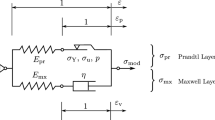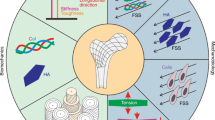Abstract
Since both connective and calcified tissues are markedly viscoelastic in nature, an understanding of the behavior of these tissues intrinsically as materials on their own, as well as in composite formation with synthetic implants, is of prime importance in order to predict and anticipate materials' design and function. Thus considerable interest has developed in recent years with respect to measurements of the viscoelastic properties of biological materials. However, attempts to characterize the viscoelasticity of calcified tissues have involved many different experimental procedures; hence results appear in terms of different functions, e.g. relaxation modulus, creep compliance. Since this diversity precludes a simple useful comparison of the results, the present study was initiated so that measured functions could be cast into a common representation, and thus compared. Linear viscoelasticity theory implies definite exact relationships between the functions. Using these relations, experimental results on bone, dentin and implant materials presently used to interface to the natural tissues, e.g. polymethyl methacrylate and high density linear polyethylene, were transformed into the complex dynamic modulus representation. Analysis shows that the results of experiments on bone are not in agreement as to dispersion (i.e. change of modulus with frequency) and its variation with strain. Further, analysis of the internal consistency of some experiments demonstrates a violation of the Boltzmann integral which indicates that linear viscoelasticity (almost invariably assumed by workers in the field) fails for bone in compression. It is concluded that the dynamic behavior of bone is not as well understood as has been thought heretofore; direction is given for future experiments.
Similar content being viewed by others
References
Bechtol, C. O., “Replacement of Living Tissue”. InMetals and Engineering in Bone and Joint Surgery by Bechtol, C. O., Ferguson, A. B., Jr., and Laing, P. G., Chapter 7, (Williams and Wilkins Co., Baltimore, 1959), pp. 143–146.
Lakes, R. S. and Katz, J. L., “Interrelationships Among the Viscoelastic Functions for Anisotropic Solids: Application to Calcified Tissues and Related Systems”,J. Biomech.,7, (1974), 259.
Yoon, H. S. and Katz, J. L., “The Elastic Properties and Microstructure of Human Cortical Bone: Experimental”. Paper presented at the 51st General Session of the International Association for Dental Research, (Washington, D.C., April, 1973).
Katz, J. L. and Yoon, H. S., “The Elastic Properties and Microstructure of Human Cortical Bone: Theoretical”. Paper presented at the 51st General Session of the International Association for Dental Research, (Washington, D.C., April, 1973).
Dempster, W. T. and Liddicoat, R. T., “Compact Bone as a Non-Isotropic Material”,Am. J. Anat.,91, (1952), 331.
Ferry, J. D.,Viscoelastic Properties of Polymers, (John Wiley and Sons, Inc., New York, 1970).
Black, J., “Strain Related Potentials in Viable Human Cortical Bone”. Ph.D. Dissertation, Metallurgy and Materials Science, (University of Pennsylvania, 1972).
Lugassy, A. A., “Mechanical and Viscoelastic Properties of Bone and Dentin in Compression”. Ph.D. Dissertation, Metallurgy and Materials Science, (University of Pennsylvania, 1968).
McElhaney, J., “Dynamic Response of Bone and Muscle Tissue”,J. Appl. Physiol.,21, (1966), 1231.
Smith, R. and Keiper, D., “Dynamic Measurement of Viscoelastic Properties of Bone”,Am. J. Med. Elec.,4, (1965), 156.
Koppelmann, V. J., “Uber die Bestimmung des dynamischen Elastizitatsmoduls und des dynamischen Schubmoduls im Frequenzbereich von 10−5 bis 10−1 Hz”,Rheologica Acta,1, (1958), 20.
Pugh, J. W.; Rose, R. M. and Radin, E. L., “On the Elastic and Viscoelastic Properties of Trabecular Bone: Dependence on Structure”, (Massachusetts Institute of Technology-Technical Report, ref. 471:W9R:pwh, NR032-534).
Paul, J. P., “Load Actions on the Human Femur in Walking and Some Resultant Stresses”,Experimental Mechanics,11, (1971), 121.
Morrison, J. B., “Function of the Knee Joint in Various Activities”,BioMedical Engineering,4, (1969), 573.
Fung, Yuan-Cheng B., “Biomechanics: Its Scope, History, and Some Problems of Continuum Mechanics in Physiology”,Applied Mechanics Reviews,21, (1968), 1.
Haut, Roger C. and Little, Robert W., “A Constitutive Equation for Collagen Fibers”,J. Biomech.,5, (1972), 423.
Katz, J. L., “Hard Tissue as a Composite Material: I. Bounds on the Elastic Behavior”,J. Biomech,4, (1971), 455.
Katz, J. L., “Bone: A Composite Material”. Paper presented at the 1970 Gordon Conference on the Science and Technology of Biomaterials, (Proctor Academy, Andover, N.H., June, 1970).
Moyle, D. D.; Klawitter, J. J. and Hulbert, S. F., “Mechanical Properties of the Bone-Porous Biomaterial Interface; Elastic Behavior”. Paper presented at the Fourth Series of Bioengineering Symposiums entitled: “Materials and Design Considerations for the Attachment of Prostheses to the Musculo-Skeletal System”, (1972).
Duncanson, M. G., Jr., “Compression Measurements of the Stress Relaxation Behavior of Human Dentin”. Ph.D. Dissertation, Metallurgy and Materials Science, (University of Pennsylvania, 1972).
Craig, R. G. and Peyton, F. A., “Elastic and Mechanical Properties of Human Dentin”,J. Dent. Res.,37, (1958), 710.
Author information
Authors and Affiliations
Additional information
Contribution No. 59 from the Laboratory for Crystallographic Biophysics; supported by USPHS through NIDR Grant Number 5T1-DE-117-10.
Rights and permissions
About this article
Cite this article
Lakes, R.S., Katz, J.L. Transformation of the viscoelastic functions of calcified tissues and interfacial biomaterials into a common representation. J Biol Phys 2, 193–204 (1974). https://doi.org/10.1007/BF02308985
Issue Date:
DOI: https://doi.org/10.1007/BF02308985




